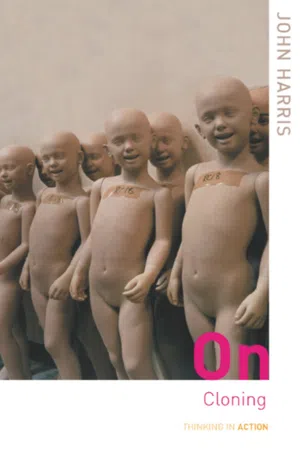Artificial Cloning
Artificial cloning is the process of creating genetically identical copies of an organism, typically through asexual reproduction. This can be achieved through various techniques such as somatic cell nuclear transfer or embryo splitting. Artificial cloning has applications in scientific research, agriculture, and medicine, but also raises ethical and moral concerns.
3 Key excerpts on "Artificial Cloning"
- eBook - ePub
- Arthur L. Caplan, Robert Arp, Arthur L. Caplan, Robert Arp(Authors)
- 2013(Publication Date)
- Wiley-Blackwell(Publisher)
...Part 3 Were It Physically Safe, Would Human Reproductive Cloning Be Acceptable? Introduction Cloning is the process whereby a genetically identical copy (the clone) of some biological entity is produced, these entities including genes, cells, tissues, and even entire organisms. Cloning occurs naturally, as when certain plants and bacteria reproduce asexually, or when identical twins are born to humans or other animal species (Klotzko, 2003; Brown, 2010). Artificial Cloning by researchers has been taking place since at least the mid 1950s. There are three types: gene cloning (or DNA cloning) is concerned with producing cloned segments of DNA or copies of genes; therapeutic cloning primarily is concerned with producing cloned embryonic stem cells that can be used to create tissues so as to ultimately treat an injury or disease; reproductive cloning is concerned with producing a cloned genetic duplicate of an existing organism (Wilmut et al., 2000). Robert William Briggs and Thomas Joseph King are credited with the first cases of reproductive cloning of animals—northern leopard frogs (Rana pipiens), native to Canada and the US—in 1952 (Briggs & King, 1952; Di Berardino & McKinnell, 2004). In 1996, the “world’s most famous sheep,” named Dolly, was the first mammal to be cloned from an adult somatic cell by Ian Wilmut and colleagues at the Roslin Institute in Scotland (McKie, 1997; Wilmut et al., 1997). Thus far, clones of animals such as mice, rats, cats, dogs, horses, mules, camels, cows, chickens, and rabbits, to name but a few species, have been produced through reproductive cloning (Guardian, 2011). A cloned Pyrenean ibex was born from a domestic goat in 2008, an amazing feat, since this particular ibex species went extinct in 2000 (Gray & Dobson, 2009; Piña-Aguilar et al., 2009)...
- eBook - ePub
- John Harris(Author)
- 2004(Publication Date)
- Routledge(Publisher)
...Finally there are fundamental issues about the standards of evidence and argument that we do or should demand before we attempt to control or limit human freedom. All of these questions and issues are of the first importance and all of them come together and are engaged when we consider the ethical, legal and regulatory issues presented by human cloning. It is these questions and issues that are the subject and object of this book. Before investigating these issues, however, we should be clear about just what cloning means and how it came about. WHAT IS CLONING? 1 Cloning refers to asexual reproduction, reproduction without ‘fertilisation’. A cloned individual (clone from the Greek Klon, ‘twig’, ‘slip’) may result from two different processes: (1) Embryo splitting: this sometimes gives rise to monozygotic twins but can also result in identical triplets or even quadruplets. 2 (2) Cell Nuclear Replacement (CNR) or Cell Nuclear Transfer (CNT). This was the procedure that produced Dolly. CNR involves two cells: a recipient, which is generally an egg (oocyte), and a donor cell. Early experiments mainly made use of embryonic cells, which were expected to behave similarly to the cells of a fertilised egg, in order to promote normal development after the nuclear replacement. In more recent experiments, the donor cells were taken from either fetal or adult tissues. The nucleus of the donor cell is introduced into the egg (either by cell fusion or by injection). With appropriate stimulation – electric pulses or exposure to chemicals – the egg is induced to develop. The embryo thus created may be implanted in a viable womb, and then develops in the normal way to term, although the failure rate has so far been high. It is clear then that cloning did not start with the birth of Dolly nor yet did artificially produced clones start with the birth of Dolly...
- eBook - ePub
- Firdos Alam Khan(Author)
- 2020(Publication Date)
- CRC Press(Publisher)
...This process has been referred to as cloning. To date, somatic cell nuclear transfer has been used to clone cattle, sheep, pigs, goats, horses, mules, cats, rats, and mice. The technique involves culturing somatic cells from an appropriate tissue (fibroblasts) from the animal to be cloned. Nuclei from the cultured somatic cells are then microinjected into an enucleated oocyte obtained from another individual of the same or a closely related species. Through a process that is not yet understood, the nucleus from the somatic cell is reprogrammed to a pattern of gene expression suitable for directing normal development of the embryo. The embryo is further cultured in an in vitro environment, and then it is transferred to a recipient female for normal fetal development (Figure 1.4). Another very important application of genetically modified animals is in the drug testing and toxicity evaluations. In Chapter 7, we have discussed various applications of animal biotechnology with great details supported by beautiful illustrations. 1.4 PLANT BIOTECHNOLOGY Plant biotechnology is also known as green biotechnology and involves the use of environment-friendly solutions as an alternative to traditional industrial agriculture, horticulture, and animal breeding processes...


